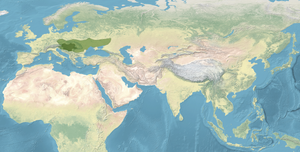
Back Aware Afrikaans Awaren ALS Avaros AN آفار أوراسيا Arabic Ávaros AST Avarlar Azerbaijani Аварҙар (күсмә халыҡ) Bashkir Awarn BAR Авары Byelorussian Авари Bulgarian
Avar Khaganate | |
|---|---|
| 567 – 822[1] | |
The Avar Khaganate ( ) and main contemporary polities c. 576 | |
 The Avar Khaganate and surroundings c. 602. | |
| Common languages |
|
| Religion | Originally shamanism and animism, Christianity after 796 |
| Government | Khanate |
| Khagan | |
| History | |
• Established | 567 |
• Defeated by Pepin of Italy | 796 |
• Disestablished | 822[1] |
The Pannonian Avars (/ˈævɑːrz/ AV-arz) were an alliance of several groups of Eurasian nomads of various origins.[8] The peoples were also known as the Obri in chronicles of Rus, the Abaroi or Varchonitai[9] (Greek: Βαρχονῖται, romanized: Varchonitai), or Pseudo-Avars[10] in Byzantine sources, and the Apar (Old Turkic: 𐰯𐰺) to the Göktürks.[11] They established the Avar Khaganate, which spanned the Pannonian Basin and considerable areas of Central and Eastern Europe from the late 6th to the early 9th century.[12]
The name Pannonian Avars (after the area in which they settled) is used to distinguish them from the Avars of the Caucasus, a separate people with whom the Pannonian Avars may or may not have had links. Although the name Avar first appeared in the mid-5th century, the Pannonian Avars entered the historical scene in the mid-6th century,[13] on the Pontic–Caspian steppe as a people who wished to escape the rule of the Göktürks. They are probably best known for their invasions and destruction in the Avar–Byzantine wars from 568 to 626 and influence on the Slavic migrations to Southeastern Europe.
Recent archaeogenetic studies indicate that the Pannonian Avars were of primarily Ancient Northeast Asian ancestry similar to those of modern-day people from Mongolia and the Amur River region in Manchuria, pointing to an initial rapid migration of nomadic tribes into the centre of Europe from the Eastern Eurasian Steppe. The Pannonian Avars' core may have been descended from the remnants of the Rouran Khaganate, which were accompanied by other Steppe groups.[14][15][16][17][18][19][note 1]
- ^ Waldman & Mason 2006, p. 769.
- ^ Curta 2004, pp. 125–148.
- ^ Helimski 2004, pp. 59–72.
- ^ de la Fuente 2015.
- ^ Curta 2004, p. 132.
- ^ Some sources claim that Khagan Theodorus and his predecessor Zodan were one and the same; that is, Zodan assumed the name Thedours after converting to Christianity.
- ^ The name of Khagan Isaac appears to have been corrupted into Latin as Canizauci princeps Avarum ("Khagan Isaac, Prince of the Avars").
- ^
- Encyclopædia Britannica & Avar
- Frassetto 2003, pp. 54–55
- Waldman & Mason 2006, pp. 46–49
- Beckwith 2009, pp. 390–391: "... the Avars certainly contained peoples belonging to several different ethnolinguistic groups, so that attempts to identify them with one or another specific eastern people are misguided."
- Kyzlasov 1996, p. 322: "The Juan-Juan state was undoubtedly multi-ethnic, but there is no definite evidence as to their language... Some scholars link the Central Asian Juan-Juan with the Avars who came to Europe in the mid-sixth century. According to widespread but unproven and probably unjustified opinion, the Avars spoke a language of the Mongolic group."
- Pritsak 1982, p. 359
- ^ Encyclopedia of Ukraine & Avars.
- ^ Grousset 1939, p. 171:According to Grousset, Theophylact Simocatta called them pseudo-Avars because he thought the true Avars were the Rouran.
- ^ Kultegin Inscription
- ^ Pohl 2002, pp. 26–29.
- ^ Curta 2006.
- ^ Neparáczki & Maróti 2019.
- ^ Csáky & Gerber 2020.
- ^ Gnecchi-Ruscone et al. 2022.
- ^ Maróti, Neparáczki & Schütz 2022.
- ^ David 2022.
- ^ Saag & Staniuk 2022, pp. 38–41.
Cite error: There are <ref group=note> tags on this page, but the references will not show without a {{reflist|group=note}} template (see the help page).

